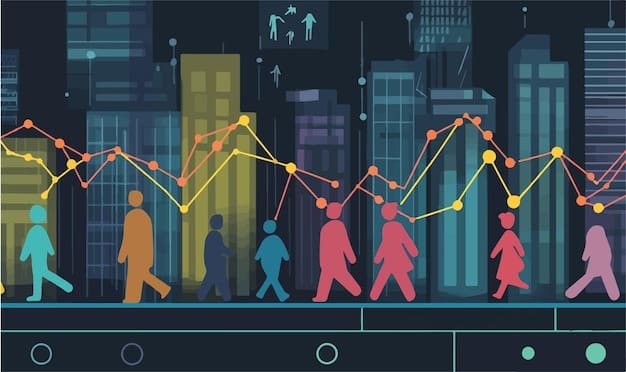Understanding Social Security Changes in 2025: A Comprehensive Guide

Understanding the Proposed Changes to Social Security Benefits in 2025: A Comprehensive Guide delves into potential adjustments to eligibility, benefits calculation, and funding mechanisms, offering insights for future planning.
Are you concerned about the future of your Social Security benefits? With potential changes on the horizon, understanding the proposed changes to Social Security benefits in 2025: a comprehensive guide is crucial for those nearing retirement or already receiving benefits.
This guide aims to break down complex policy and legislative matters, providing you with a clear overview of how these changes might affect your financial future and what proactive steps you can take. Let’s delve into understanding the proposed changes to Social Security benefits in 2025: a comprehensive guide.
Understanding the Impetus Behind Proposed Changes
The Social Security system, a cornerstone of financial security for millions of Americans, faces significant long-term funding challenges. To ensure its sustainability, various reforms have been proposed. Let’s explore the driving factors behind these potential adjustments.
Demographic Shifts
One of the primary reasons for the proposed changes is the shifting demographic landscape of the United States. We’re seeing an aging population with decreasing birth rates. This means fewer workers are contributing to the system for each beneficiary receiving payments.
Economic Factors
Fluctuations in economic growth, inflation, and interest rates also play a crucial role in Social Security’s financial health. Lower economic growth can reduce the tax revenue flowing into Social Security. On the other hand, increasing inflation could lead to higher benefit payments as adjustments are made to the Consumer Price Index.
- Aging Population: Fewer workers supporting more retirees.
- Low Birth Rates: Reduced workforce entering the system.
- Economic Volatility: Impacts on tax revenue and benefit payouts.
In summary, understanding the interplay between demographic and economic forces is essential for grappling with the necessity of Social Security reforms. These factors collectively create a pressing need to address the long-term solvency of the system, leading to proposals for modifying various aspects of Social Security benefits.

Key Proposed Changes to Social Security Benefits in 2025
So what are the specific changes concerning understanding the proposed changes to Social Security benefits in 2025: a comprehensive guide? Several key adjustments have been discussed to address the challenges facing the system. Here are some of the most notable proposals:
Adjustments to the Retirement Age
One commonly discussed change involves gradually increasing the full retirement age (FRA). Currently, the FRA is 67 for those born in 1960 or later. Raising this age would mean individuals need to wait longer to receive their full benefits.
Changes to the Benefit Calculation
Another area of potential reform is the formula used to calculate retirement benefits. Proposals include modifying the way cost-of-living adjustments (COLAs) are determined. These changes could affect the annual increases beneficiaries receive to keep up with inflation.
- Increased Retirement Age: Waiting longer for full benefits.
- Modified COLA Calculations: Potential impact on annual benefit increases.
- Adjustments to Earnings Base: Changes in taxable income levels.
These proposed changes, while aimed at stabilizing the system, may have varying impacts on different individuals. It’s crucial to understand that these are only potential changes, and the final decisions will likely result from extensive debate and compromise.
Understanding the Impact on Different Demographics
The proposed changes will affect different demographics in unique ways. Understanding the proposed changes to Social Security benefits in 2025: a comprehensive guide requires a nuanced view of how these reforms might impact distinct age groups, income levels, and working statuses.
Younger Workers
Younger individuals entering the workforce could face a higher retirement age and potentially altered formulas for benefit calculation. These changes would require them to save more for retirement and adjust their financial planning accordingly.
Older Workers Nearing Retirement
For those closer to retirement, the impact could be more immediate and significant. Changes such as adjustments to COLAs or slight increases in the retirement age could directly affect their anticipated benefits.
- Younger Workers: Need for increased savings and adjusted planning.
- Older Workers: Direct impact on anticipated benefit amounts.
- Low-Income Individuals: Potential changes to supplemental income programs.
Each demographic faces a unique set of challenges and opportunities in light of these proposals. Tailoring financial strategies to these specific impacts will be crucial for navigating the changing landscape of Social Security benefits.
Potential Legislative Pathways and Timelines
The process for enacting changes to Social Security involves extensive legislative action. Understanding the proposed changes to Social Security benefits in 2025: a comprehensive guide also means knowing how these changes are likely to be implemented. Let’s look at possible pathways and expected time horizons.
Congressional Action
Any significant reform to Social Security requires approval from both the House of Representatives and the Senate. Different proposals will be introduced, debated in committees, and ultimately voted upon by the full Congress. Bipartisan support is often necessary for major changes.
Presidential Approval
Once Congress passes legislation, it must be signed into law by the President. Depending on the political climate, the President’s stance can significantly influence the likelihood of certain reforms being enacted. The path to reforming Social Security is complex and requires navigating political dynamics and varied stakeholder interests.

Strategies for Maximizing Your Social Security Benefits
Given the uncertainties surrounding Social Security, it’s wise to take proactive steps to maximize your expected benefits. Let’s explore sound strategies to consider.
Delaying Benefits
One of the most effective ways to increase your Social Security payout is to delay claiming benefits. For each year you postpone, your benefit increases, up until age 70. This can result in a substantially higher monthly income during retirement.
Working Longer
Working for a few additional years can also boost your benefits, as Social Security calculates your payout based on your 35 highest-earning years. If you have years with lower earnings, adding higher-earning years can significantly increase your average.
- Delay Benefit Claims: Increase payout by waiting until age 70.
- Work Longer: Boost average earnings with additional high-income years.
- Coordinate with Spouse: Optimize benefits within a married couple.
By employing strategies such as delaying benefits and working longer, individuals can mitigate some of the uncertainties surrounding Social Security and enhance their long-term financial security.
Staying Informed and Seeking Professional Advice
Staying informed about potential changes to Social Security and seeking professional advice are essential steps in planning for your future. Understanding the proposed changes to Social Security benefits in 2025: a comprehensive guide is just the start.
Reliable Resources
Consult official government websites like the Social Security Administration (SSA) for accurate and up-to-date information. Be wary of unofficial sources that might spread misinformation.
Financial Advisors
Consider consulting a qualified financial advisor who can provide personalized guidance based on your particular circumstances. They can help you develop a comprehensive retirement plan that aligns with potential Social Security changes.
| Key Point | Brief Description |
|---|---|
| 📊 Demographic Shifts | Aging population requires system adjustments. |
| 💰 Benefit Calculation | Adjustments can impact yearly increases. |
| 📅 Legislative Action | Changes need Congressional and Presidential approval. |
Frequently Asked Questions
The main factors include demographic shifts, like an aging population, and economic pressures affecting the system’s long-term solvency when understanding the proposed changes to social security benefits in 2025: a comprehensive guide.
Some proposals suggest gradually increasing the full retirement age (FRA), which could mean individuals would need to wait longer to receive their full Social Security benefits.
Yes, delaying when you claim benefits can substantially increase your monthly income during retirement, with benefits growing each year you postpone, up to age 70 according to understanding the proposed changes to Social Security benefits in 2025: a comprehensive guide.
For accurate and up-to-date details, consult official government websites like the Social Security Administration (SSA) and be sceptical about information from unverified sources.
Changes to COLA calculations can impact the annual increases beneficiaries receive to keep up with inflation, affecting the real value of your Social Security benefit over time in the face of understanding the proposed changes to Social Security benefits in 2025: a comprehensive guide.
Conclusion
Understanding the proposed changes to Social Security benefits in 2025: a comprehensive guide, we recognize the adjustments may affect different demographics in unique ways, requiring informed financial planning, strategic maximization, and proactive adjustments. Staying informed and seeking professional advice will be crucial.
The Social Security system is at a pivotal point, and it’s important to stay engaged and informed to ensure your financial security in retirement. Keep abreast of developments and adapt your plans accordingly for a secure future.





